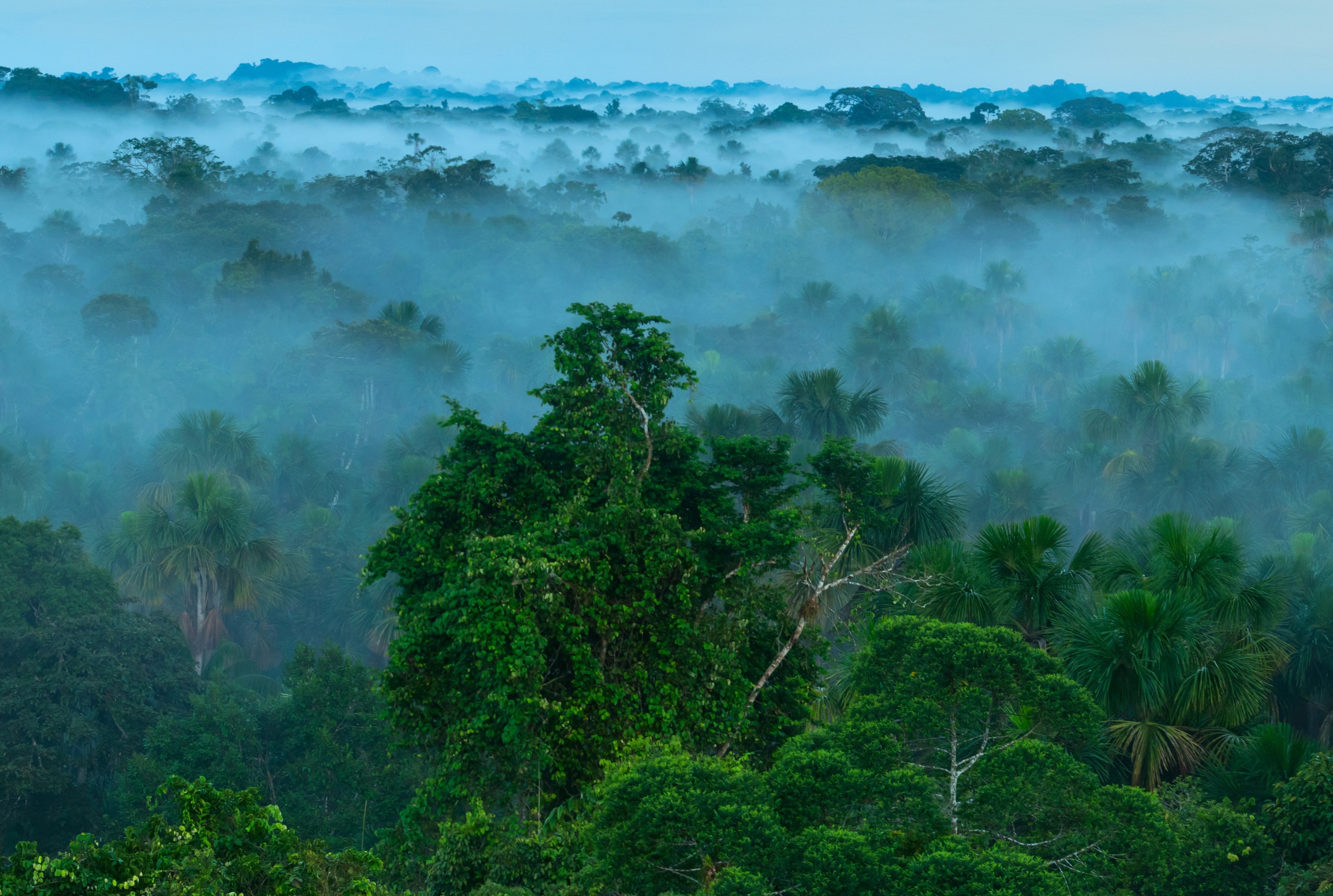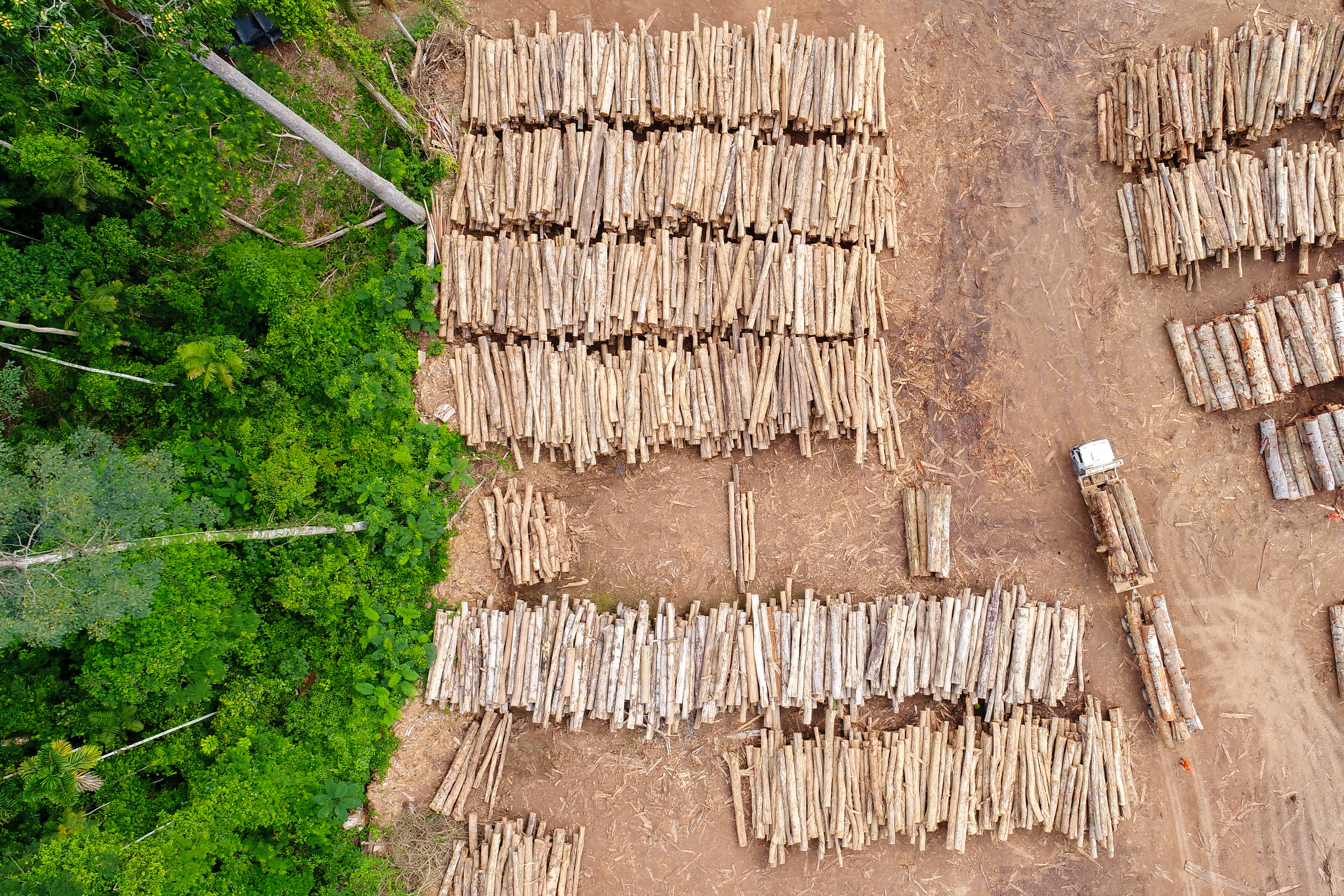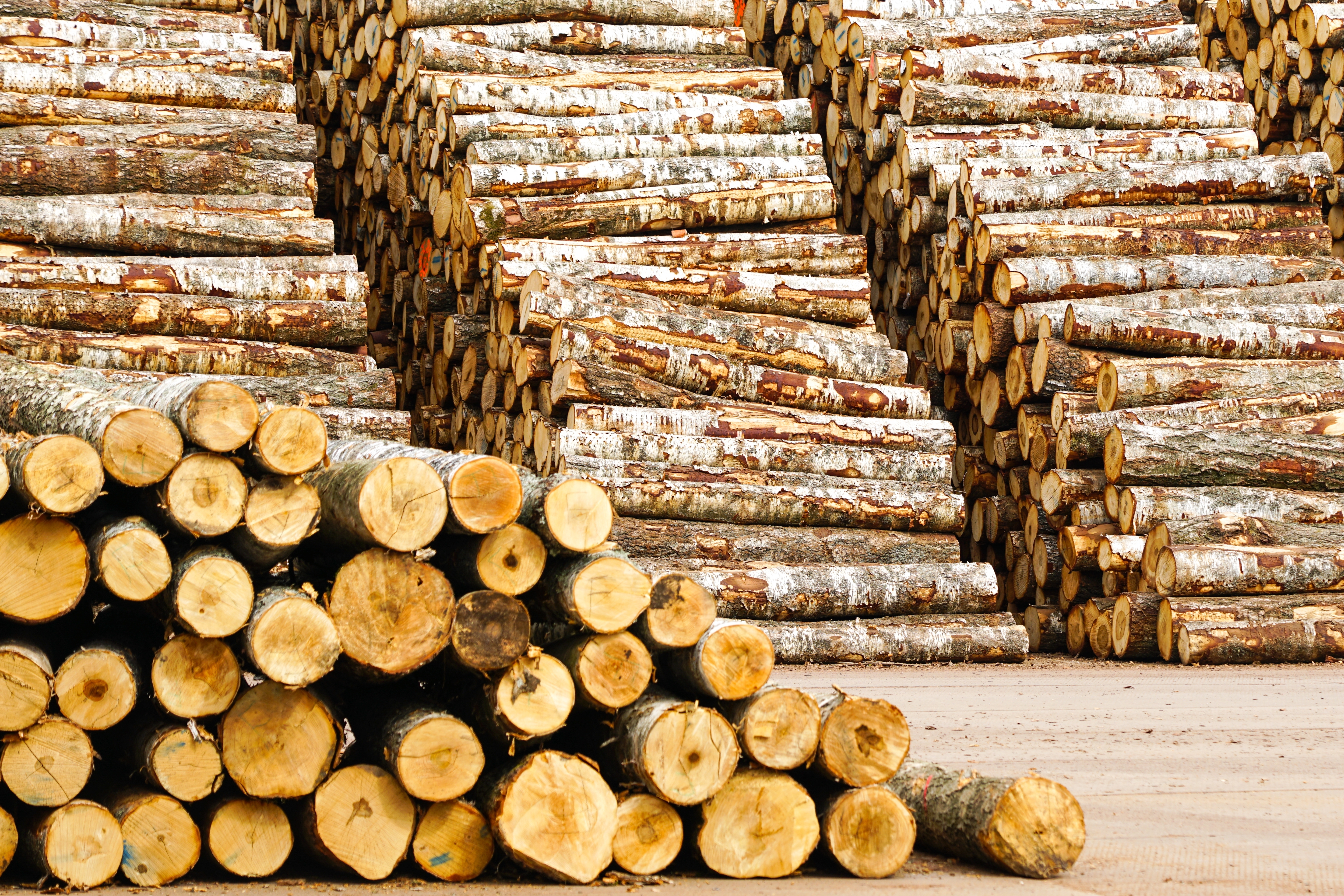- Industrial-scale agriculture poses considerable risk to the indigenous peoples of Papua, whose culture and livelihoods are closely linked to the region’s extensive rainforest.
- In November 2018, Mongabay and Earthsight's The Gecko Project published an investigative article exposing the dealings underpinning a mega-plantation project in Papua, as part of our series Indonesia for Sale.
- Anthropologist Sophie Chao has studied the often fraught relationship between Papuans and plantation firms, and the mechanisms through which indigenous people are compelled to give up their land.
- This analysis is part of the Indonesia for Sale series. See the full investigations, films and more here.
- For the latest updates and news about the Tanah Merah project, click here.
Sophie Chao is a postdoctoral research associate at the University of Sydney, whose work focuses on the impacts of agribusiness on the peoples and environments of the Asia-Pacific and Melanesia. She spent a year, for her PhD, living with and studying the Marind-Anim people of Merauke, a district in the southern lowlands of Indonesia’s Papua province that has been heavily targeted for plantation development. Prior to this she worked for the Forest Peoples Programme, a UK-based non-profit, pressing private companies and governments to respect international human rights principles in plantation developments.
The relationship between indigenous peoples, the state and
plantation companies in Papua, and Merauke in particular, is fraught. The
government has earmarked the district to produce sugar, timber and palm oil.
Indigenous Papuans are heavily dependent on the forest that is being destroyed
to be replaced by these crops. Many express a desire for “development,” but are
losing their sources of food and clean water, without any improvements to their
lives. Chao’s research has investigated the underlying cause of this conflict,
and the ways in which Papuans experience a rapidly changing world.
In November 2018, The Gecko Project and Mongabay published “The secret deal to destroy paradise,” an investigative
article exposing the murky story behind a vast palm oil plantation project in
Boven Digoel district, to the immediate north of Merauke. Papuans whose land
has been annexed by this project are just beginning to feel the impacts as
large-scale deforestation begins. We spoke to Chao for a deeper insight into
the complex tensions between the culture and worldview of people indigenous to
southern Papua and the industrial agriculture that is being imposed upon them.
The Gecko Project and Mongabay: Indigenous Papuan
culture is closely connected to the natural world. Is this something that you
think is particularly strong within Papua, compared to the rest of Indonesia?
Sophie Chao: This extension of a sentience, or agency,
or some kind of volition to animals, but in some cases plants, is found across
a whole range of indigenous societies in Indonesia, as different as their
histories and geographies may be. It does seem to be a recurring motif. The
forest for Marind and many other groups, including Dayaks that I worked with in
Kalimantan [the Indonesian part of Borneo], is a sentient ecology, or an
ecology of selves, some of whom are human, not all of whom are human. But who
all participate in shaping this dynamic space that is the forest in ways that
transcends the human. The Marind have a lot of belief in spirits, these
ancestral creator beings that are manifest within plants and animals within the
landscape. The forest is kind of a living history book, animated by these spirits
and by their animal and plant manifestations.
How do these feelings — this sense of being connected to
nature — influence their perception of plantation companies that are
encroaching on and in many cases annexing their land?
A lot of the communities I worked with have ceded their
lands to oil palm corporations. Some have signed contracts surrendering other
clans’ lands on their behalf without their consent. It’s very messy. Part of it
is that this dependence on the forest is decreasing in the light of
deforestation and monocrop expansion. Another indigenous idiom through which
people understand the negative environmental impacts of oil palm expansion —
water pollution, the haze, toxic mill effluence and so on — is as a form of
retribution on the part of these plant and animal spirits for their failure,
for the failure of Marind to protect them from oil palm, from these
destructive, external forces.
“The negative environmental impacts of oil palm expansion are seen as a form of retribution on the part of plant and animal spirits for the failure of Marind to protect them”
People use the idiom that it’s a landscape that has become
desiccated. It’s been depleted of life-giving fluids, which encompass the water
of the rivers, the wetness of the soil, blood — the sap — of animals and
plants. People’s bodies become dried out, as do the rivers. Crocodiles and fish
become ‘drunk’ on the poison that comes from the mill — the pesticides and
fertilisers. A lot of the time when I asked Marind what was the worst impact of
oil palm expansion, they would say that oil palm kills the forest. Or oil palm
kills the sago, in particular. This plant that is central to the cosmology of
Marind, their staple food starch, and therefore the destruction of sago and the
forest has implications for Marinds’ own livelihoods and subsistence.
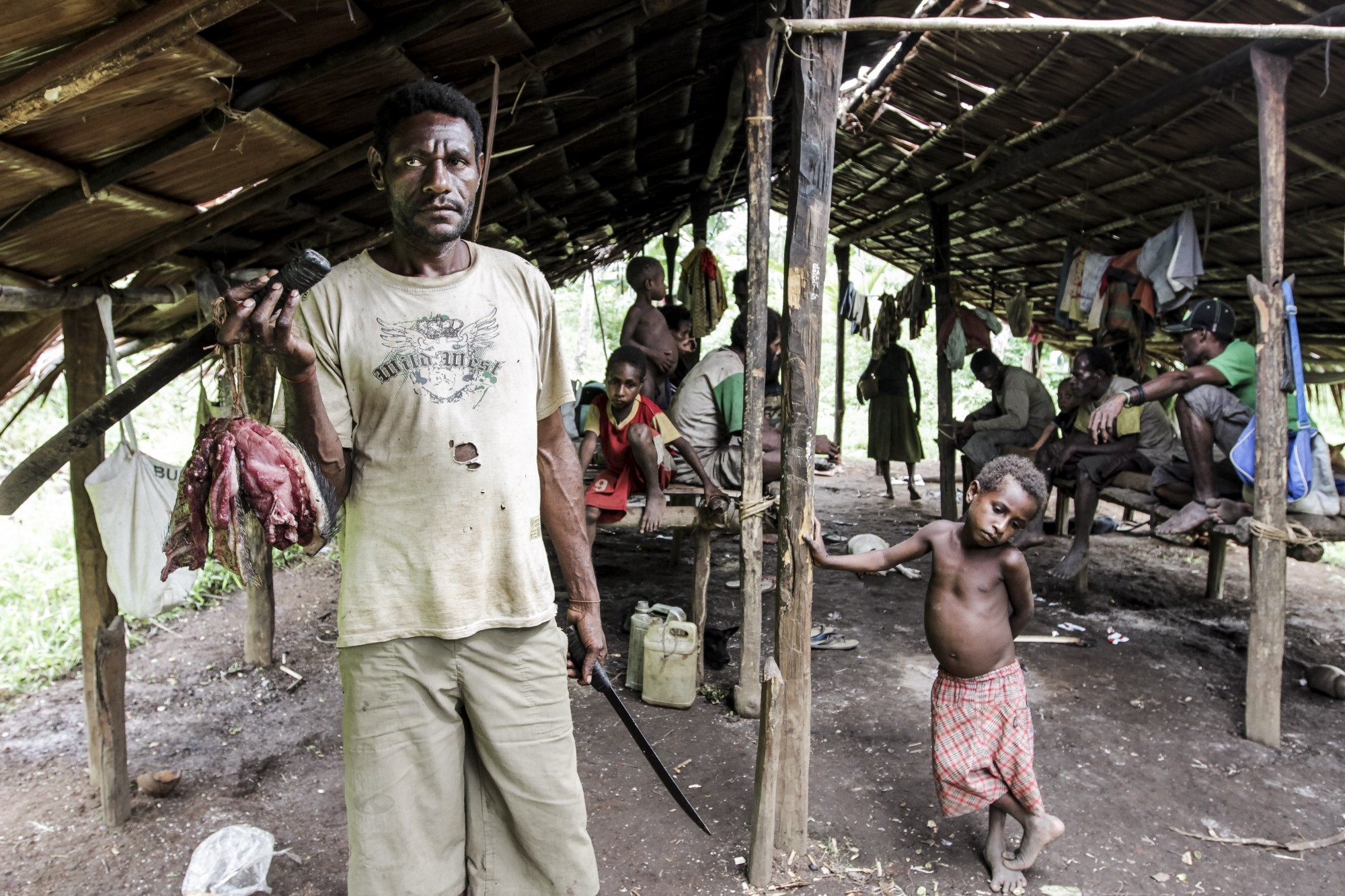
Hunter-gatherer family in Merauke, 2012
Why do you think the process becomes so messy when companies
come into these indigenous lands? Is this because of the lack of process to
decide whose rights are where, and whether they decide that they do accept the
company or not?
The lack of information is a massive issue. People are
signing contracts when they have no idea what the legal implications are.
They’re not explained the potential negative consequences. A few of them
believe the land will be returned to them when the license expires. They have
no idea that the land automatically becomes state land [when a plantation
license expires]. Most of the time people were completely unaware of that.
There’s a massive information shortage.
One of the things that’s made it really difficult for the
Marind to refuse these land deals is that the companies are very aware of the
importance of reciprocity and exchange among Marind. And it’s across the
Pacific really, and Melanesia. The idea is that if someone gives you a gift you
cannot refuse it and you must reciprocate. So companies will organise these pig
sacrifice rituals, they will give 4x4s, they will organise feasts and so on,
and that creates a sense of indebtedness and obligation on the part of the
community, who then find it very difficult to not surrender land as an
exchange, as a return to these companies. Again, this quite incisive understanding
of the value of exchange in Melanesian society tells me that they know what
they’re doing. There’s someone who understands these values, these norms, these
mores on the corporate side. That definitely creates a problem.
Those are some of the biggest reasons why there’s this
community fragmentation. Of course, there’s the prevalent scenario of plying
people with alcohol, taking them to the city, prostitution and so on. There
were several cases where men in the villages where I was working had been plied
with alcohol and slept with prostitutes. And it had all been filmed, and then
this footage was used as blackmail. There are those more immediate kinds of
strategies.
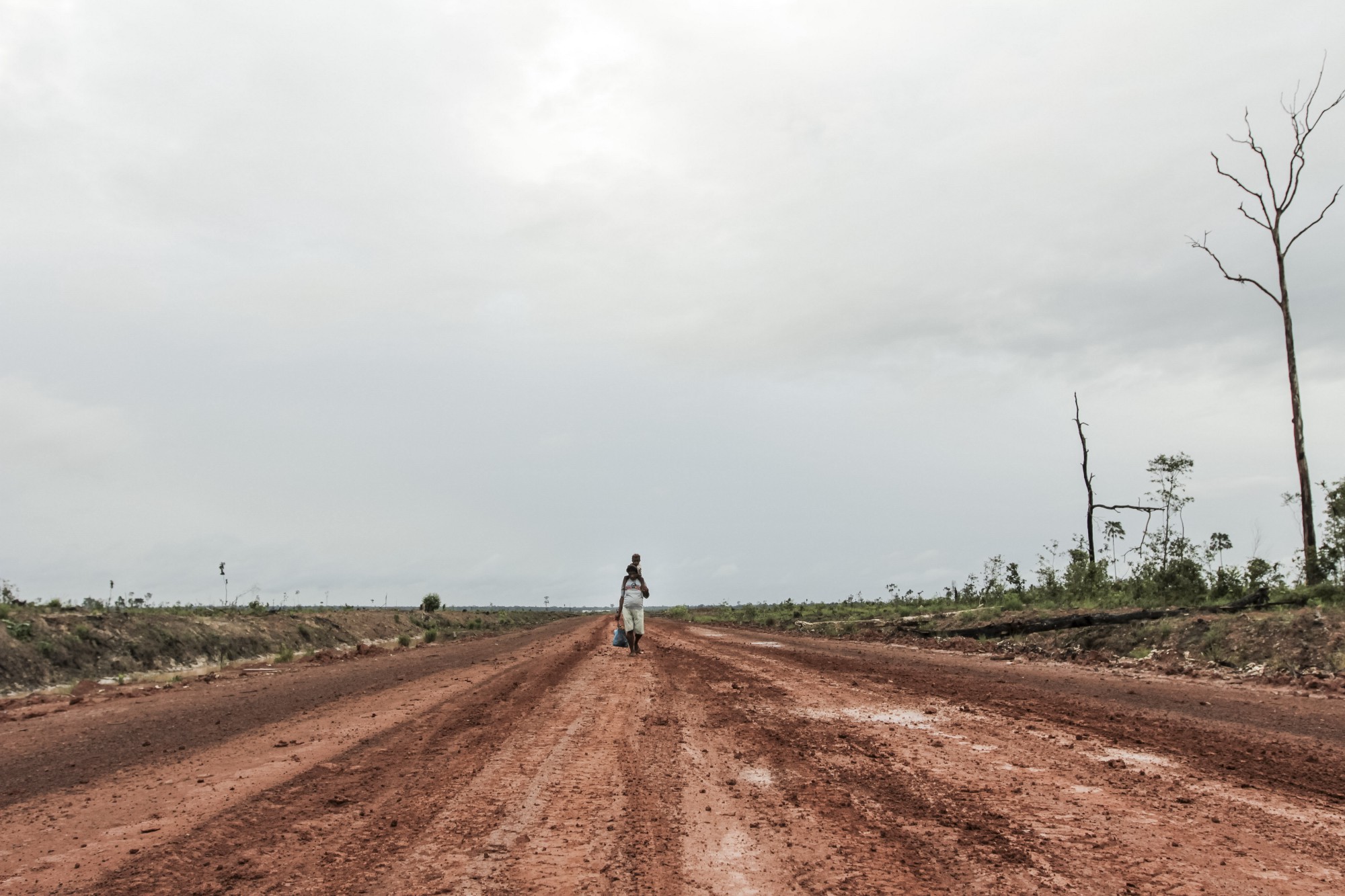
Road through a landscape denuded of forest in Merauke, 2012.
In the case that we looked at in Boven Digoel, when the
company came to the villages, they told them to prepare pigs for slaughter, for
a ceremony. Then when they came back they handed out stacks of cash. They gave
out envelopes to each clan with a large amount of money in it. Quite
arbitrarily. They used the term tali asih to describe the payment.
But the villagers were confused about what it was for. It sounds like what was
happening was that they were forcing on them some kind of gift exchange
ceremony, to force this reciprocity. It was a key moment in the story of this
project. Do you have an understanding of what tali asih would mean to
them?
My interlocutors were hugely confused over this concept
of tali asih. In part because it seemed to be used interchangeably
with ganti rugi [a fee for destroying their existing crops],
compensation, uang ketuk pintu [“door-knocking money”], a
payment, sewa hargaan [rent], kontrak sewa [lease] … I mean
the list just goes on and on. And it remains unclear what exactly the
difference is. Is this a show of goodwill? An opening-the-door gift? Is it a
gift? Is there an expectation of return? The uang ketuk pintu — I
mean it literally means the money you bring when you knock on the door. So it
suggests an invitation into a social relationship. But for the most part,
people were put in a position of feeling that they needed to reciprocate. The
only way they knew, the only thing the companies seemed interested in, was the
land. So there’s huge lack of clarity over what these terms mean.
“People find themselves forced to participate in their own practices, that are being adapted by these external actors or ‘corporate shamans’”
I’m writing something at the moment about “failed rituals.” Anthropologists
love writing about rituals in non-Western societies, particularly indigenous
ones. Fewer anthropologists, however, have written about rituals that fail, or
rituals that are problematic precisely because they do work. And how
corporations are co-opting adat [custom] through these pig sacrifices
and so on. And people find themselves forced to participate in their own
practices, that are being adapted by these external actors or ‘corporate
shamans,’ if you wish. And the problem is, even though these corporate actors
are not Marind, they’re not ritual experts, they’re not related to Marind,
they’re still able to carry out these rituals. And the problem is these rituals
work. People get cured. People heal. So it’s hugely problematic. “They’re using
our norms, our values, they’re not Marind, and it’s working … so are they
shamans? Do they have these forces or powers that we thought were our
prerogative? And if so how do we deal with that?” It’s fascinating the way
reinvention of tradition can happen, and can be manipulated and exploited to
serve very different uses. And effectively forcing people to participate in
these subverted reinventions of tradition.
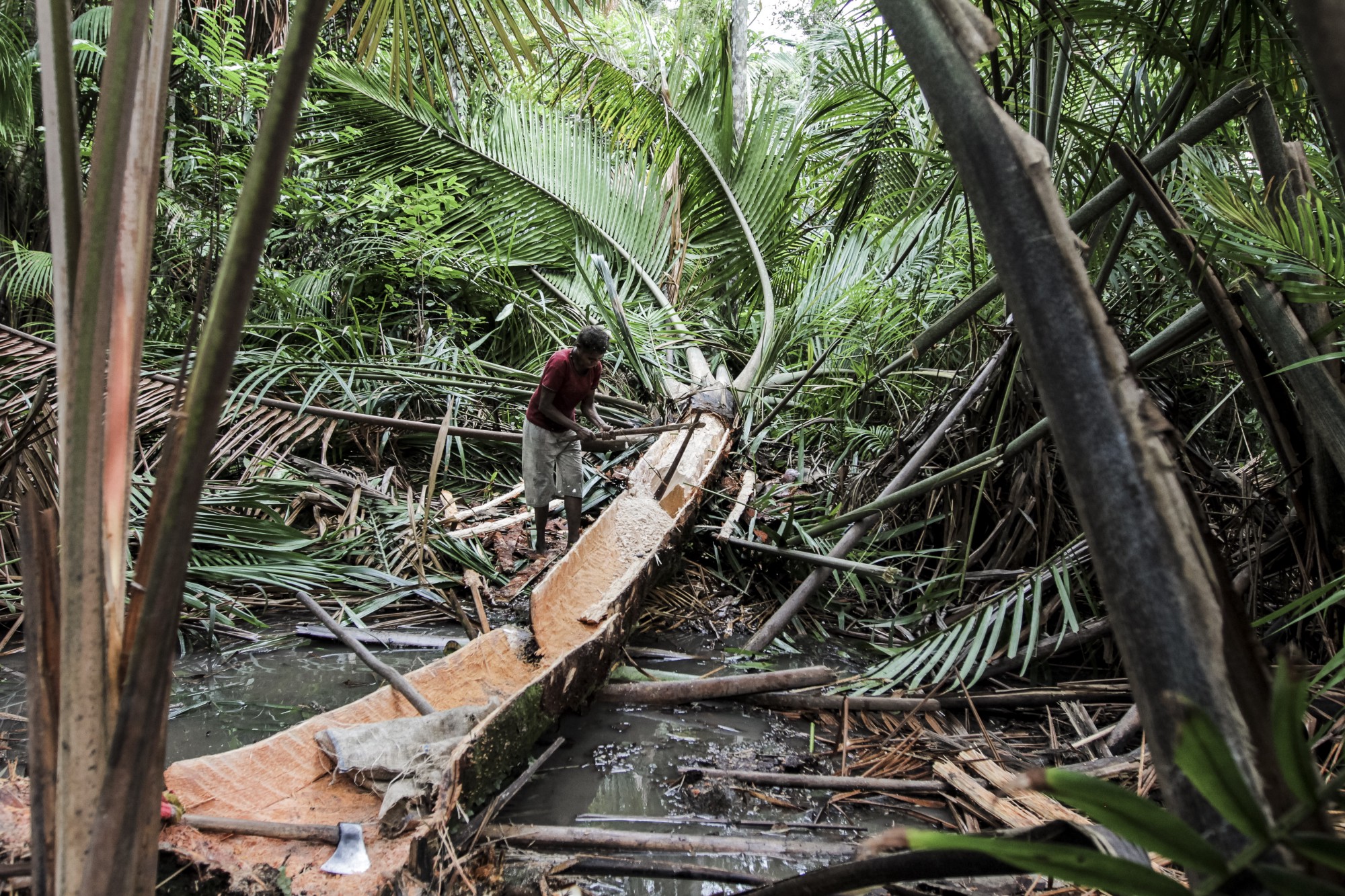
Woman harvesting sago in Merauke, 2012.
It was a bit like a hand grenade in Boven Digoel. That
seemed to be the point at which things blew up with the clans. There was a lot
of suspicion over who got what, and what it was for. They’re very clear that
before that point they were fairly peaceful, and after that point they were
literally in some cases having punch-ups. Could you talk a little bit about the
impact on the social fabric?
There’s a huge intergenerational problem in many of the
villages I was working in. That level of societal relationship is breaking down.
It works in both directions. Some of the elders who are adamant that the forest
should be preserved versus the younger generation who are looking to progress,
to change to modernity, material wealth, access to the cities. Access to the
modern world. There’s that intergenerational tension. Then you also have it in
the other direction, where there are young, educated Marind — schoolteachers,
nurses, for instance — who are deeply critical of the elders who are also
surrendering their land without understanding the terms of the contracts, the
legal implications. Who are still operating in this reciprocity framework.
“Young people are pushing for a transformation in Marind culture as a way of surviving these new forces”
[Young people would say,] “That works just fine among
Marind, but you’re not dealing with Marind here. You need to change, our
culture needs to change and adapt because we’re dealing with a very different
kind of audience, who does not reciprocate in the same way, who does not
understand reciprocity in the same way.” So some of these young people are
pushing for kind of a transformation in Marind culture as a way of surviving
these new kinds of forces and actors that are impinging upon everyday life.
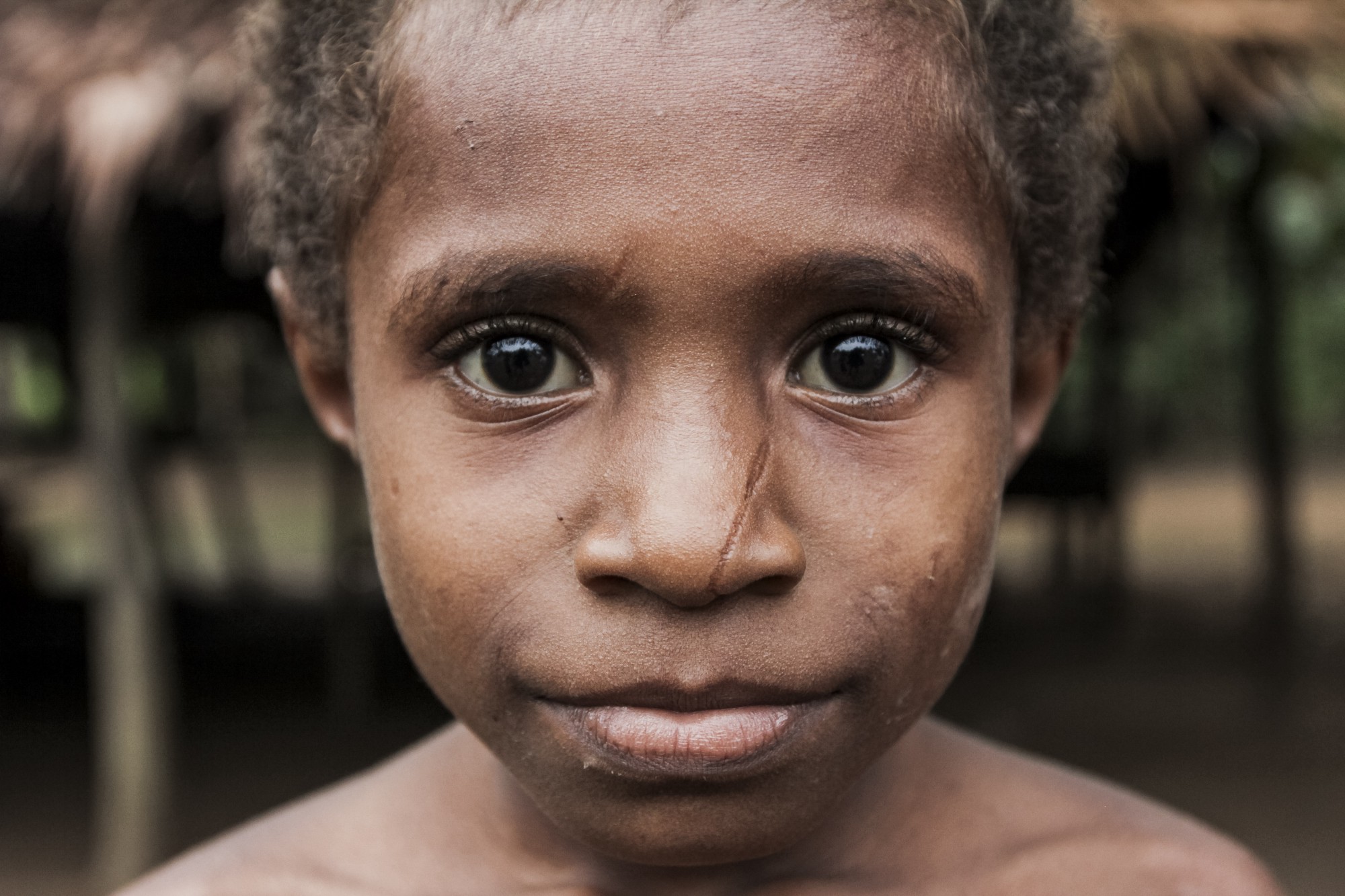
Child in Merauke, 2012.
We’ve seen maps produced by the company of the clan
territory within their concession. It shows little parcels of land that the
Auyu [an indigenous group in Boven Digoel] have allegedly ceded to the company,
which of course are nice neat square lines. You have previously written about the complexity of mapping
Marind land, where they have a much more complex concept of nature and space.
Could you say what a map of clan territory that was accurately produced might
look like?
It would depend on the season. It would depend on which clan
is doing the mapping. It would be a 3D map. It would be a map that has a sound
accompaniment to it. It would have to be a map that is open to revision. Which
kind of goes against the whole idea of the GPS, aerial, putatively objective,
top-down point of view of relatively static objects and places. But it would
have to be a map that’s open to revision. When peoples’ relationships to other
clans change, they want the GPS points to be moved. Either drawn closer, or
further away. When fortunate or auspicious events happen in the forest
involving particular animals that belong to another clan, again the boundaries
have to change.
“The forest is kind of a living history book, animated by these spirits and by their animal and plant manifestations”
So these cartographic technologies would have to incorporate
the fluidity to accommodate a multi-sensory way of perceiving the world, which
would entail sound. A map that would be able to represent movement. I don’t
know if overlays of different maps would help. One of the biggest issues we had
was people follow the movement of animals, because the movement of animals
helps them trace or identify their own boundaries. Because a lot of them follow
the migration patterns or feeding, mating movements of animals, and these are
inscribed in myth as well. So different maps that represent different species’
movements across the landscape. So it would have to be maps that are open to
change, and that incorporate sound.
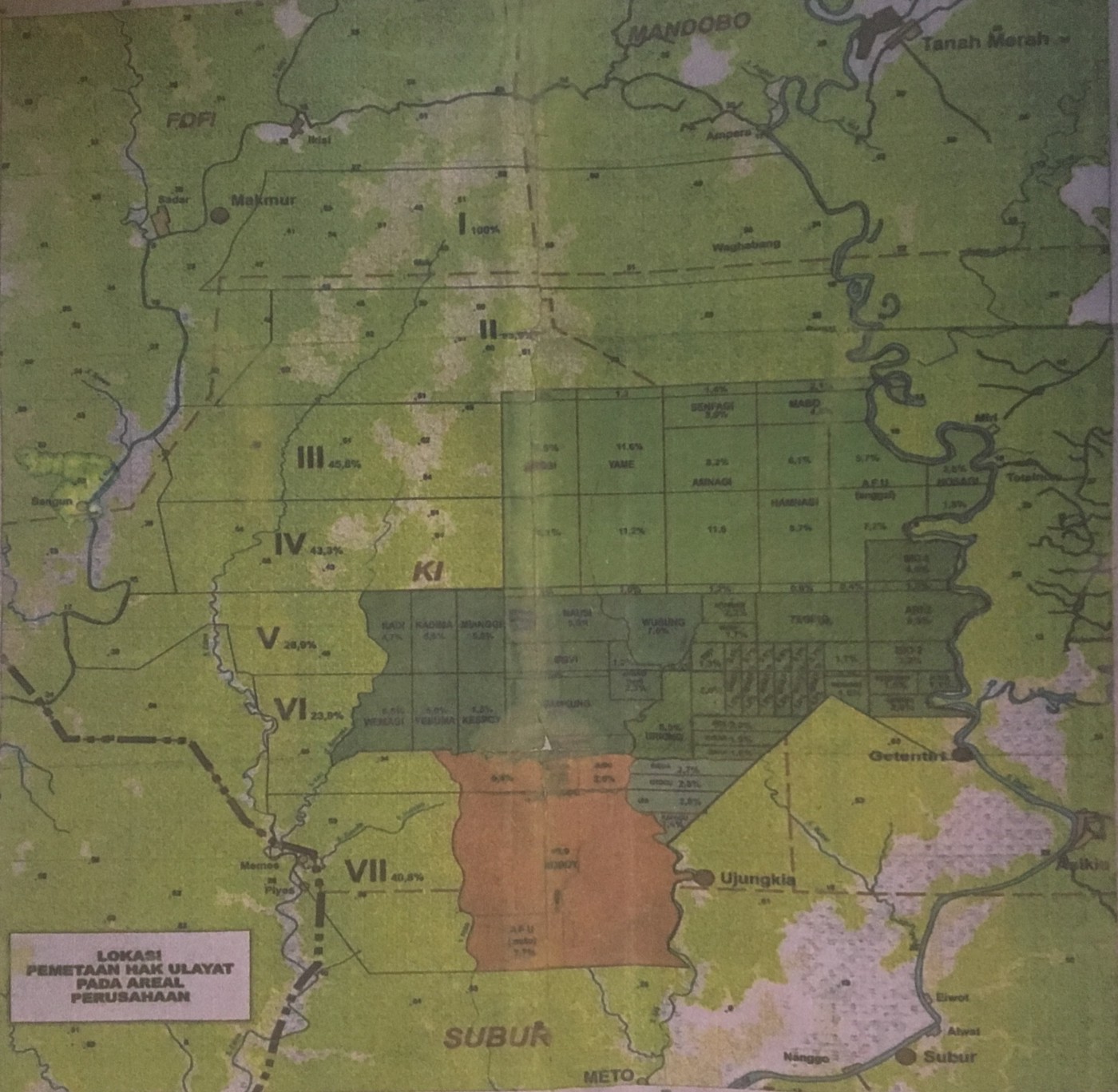
A map of indigenous territories within the Tanah Merah project, in Boven Digoel, reflects a crude and inaccurate understanding of land use.
So it would be accurate to say that such maps have to
reflect a much more complex relationship to nature than we have?
Absolutely. I remember asking one of my informants, what are
maps about for you? What is a map? And he said, “Songs and stories.” I went out
there with an activist mind-set, let’s make a map of the territory, this is
going to be really important evidence. [And instead] I went around basically
mapping bird sounds. And hearing these incredibly wonderful, protracted stories
about these animals, where they come from, what relations pertained to them. So
songs — human and bird. Stories — human and bird. Which then in turn led to all
kinds of other narratives — events, myths and so on.
“I remember asking one of my informants, what are maps about for you? And he said, ‘Songs and stories.’”
It’s a very moving process. Both in the sense that it’s
about mapping movement, and it’s very moving for the people who do it. Because
it’s as much about what’s being mapped as the person doing the mapping. The
individual who is doing this cartography is invested in the process. He or she
will produce a map that is inherently shaped by his or her relations to what is
being mapped. So, for them, they embrace the subjectivity of mapping. This idea
of top-down perspective makes very little sense.
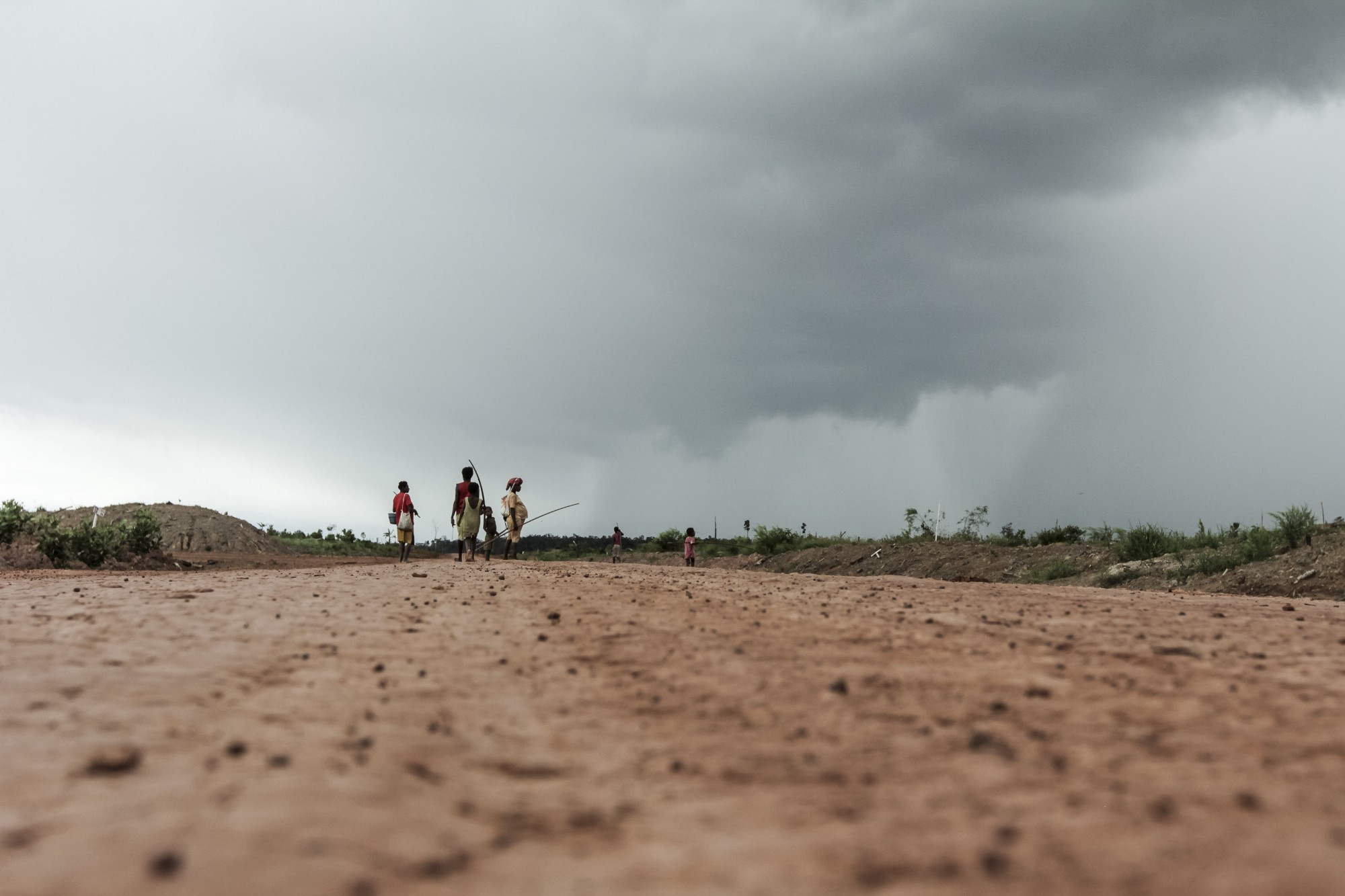
Road through a landscape denuded of forest in Merauke, 2012.
Do you think they have any means to reject or oppose these
land concessions? Does it entirely depend on a company or a government that’s
going to give them a genuine option to opt in or out, and that’s not there at
the moment?
It’s actually really hard to withhold consent in this
particular context. The military is there, doing this sosialisasi [socialization].
People have very little choice, the kind of pressures they’re facing are huge.
And then there’s retributions on people who are engaged in land rights
advocacy. Both in terms of psychological and physical harassment, the
confiscation of ID cards, extrajudicial incarceration, sporadic interrogations.
What do you think the long-term impact is going to be?
As I understand it the land can revert to the original
landowners once the HGU [35-year plantation permit] has expired, but only so
long as they are still practicing their customary way of life, still
practising hukum adat and customary land tenure. [So that is]
enforced primitivism for sure. But there’s also no way these people can still
be practicing customary land rights tenure and subsistence if their land has
been converted to monocrops. So once the HGU expires the chance of it reverting
to the communities is very, very low. There’s an inherent paradox in that
demand on communities to somehow sustain a traditional way of life in the midst
of these techno-capitalist landscapes. So, the land once ceded is very unlikely
to return to them.
It’s the relief of the forest, the particular natural
markers — the trees, the sago groves — that actually act as markers of land
boundaries between clan territories. So if the forest is gone it means there’s
actually no more reference points to identify whose land belongs to whom in
these razed landscapes. It’s complex enough now trying to identify which land
belongs to who. When those physical markers are gone, how they are going to
patch it together again and re-divide these completely demolished landscapes is
going to be a serious challenge.
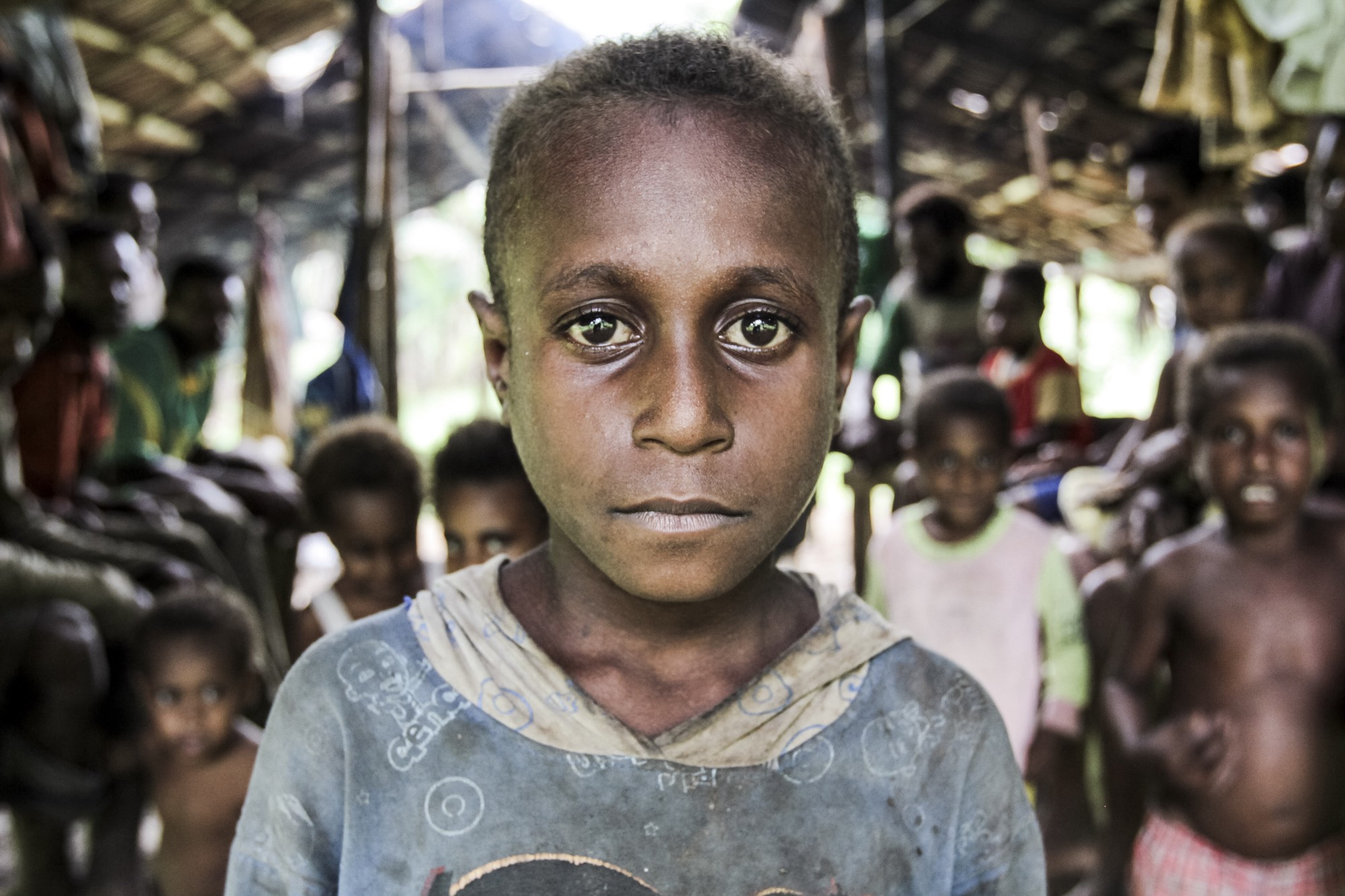
Child in Merauke, 2012.
Ten years down the line, if you’ve got these villages and
their sago groves have gone, the forest has largely gone, what do you see as
happening? In a practical sense, where do they go if they can’t get enough
food? What happens to their culture?
One of the things that could happen is the people stay in
the village, but become completely dependent on government and company
handouts. Many of the villages where I was working, you get compensation
packages. Many of the people could no longer hunt or forage. Instead they were
eating instant noodles and raskin [subsidised rice], provided by the
government and as “CSR” [corporate social responsibility] from the companies.
Indigenous food ways are being radically transformed. That has repercussions
for health. Infant malnutrition is on the rise. These foods are not nutritional
in any shape or form. So I anticipate that there will certainly be health
impacts for people who are no longer accessing the proteins from the forest and
who are now eating these processed goods of very little nutritional value. But
it could be that they end up becoming completely materially and financially
dependent on the corporation, for food and money handouts.
“Perhaps the erosion of culture will go hand in hand with a real demographic depletion”
The villages I worked with were very critical of other
villages who they deemed to have already reached that level of malas —
laziness. Just waiting for your funds to arrive, just waiting for the company
money. It’s another source of fragmentation, this internal criticism. People
who are no longer struggling, who will eat from the company rather than hunt
for themselves. And some people are. Some young Marind prefer to eat rice and
noodles, they’re not really interested in hunting anymore. They’d rather be in
the city, and they’d rather “progress,” or modernise as they put it — maju.
I suspect these changes will be inflected along generational lines. That’s as
much as I can envision at this point. Either total dependency or migration
towards the cities.
We’re talking about a people who are now a minority in their
own lands. The latest statistic is that Marind are 38 to 40 percent of the
population of Merauke. Population dilution is something to certainly keep an
eye out for. It’s real, it’s happening. So perhaps the erosion of culture will
go hand in hand with a real demographic depletion.
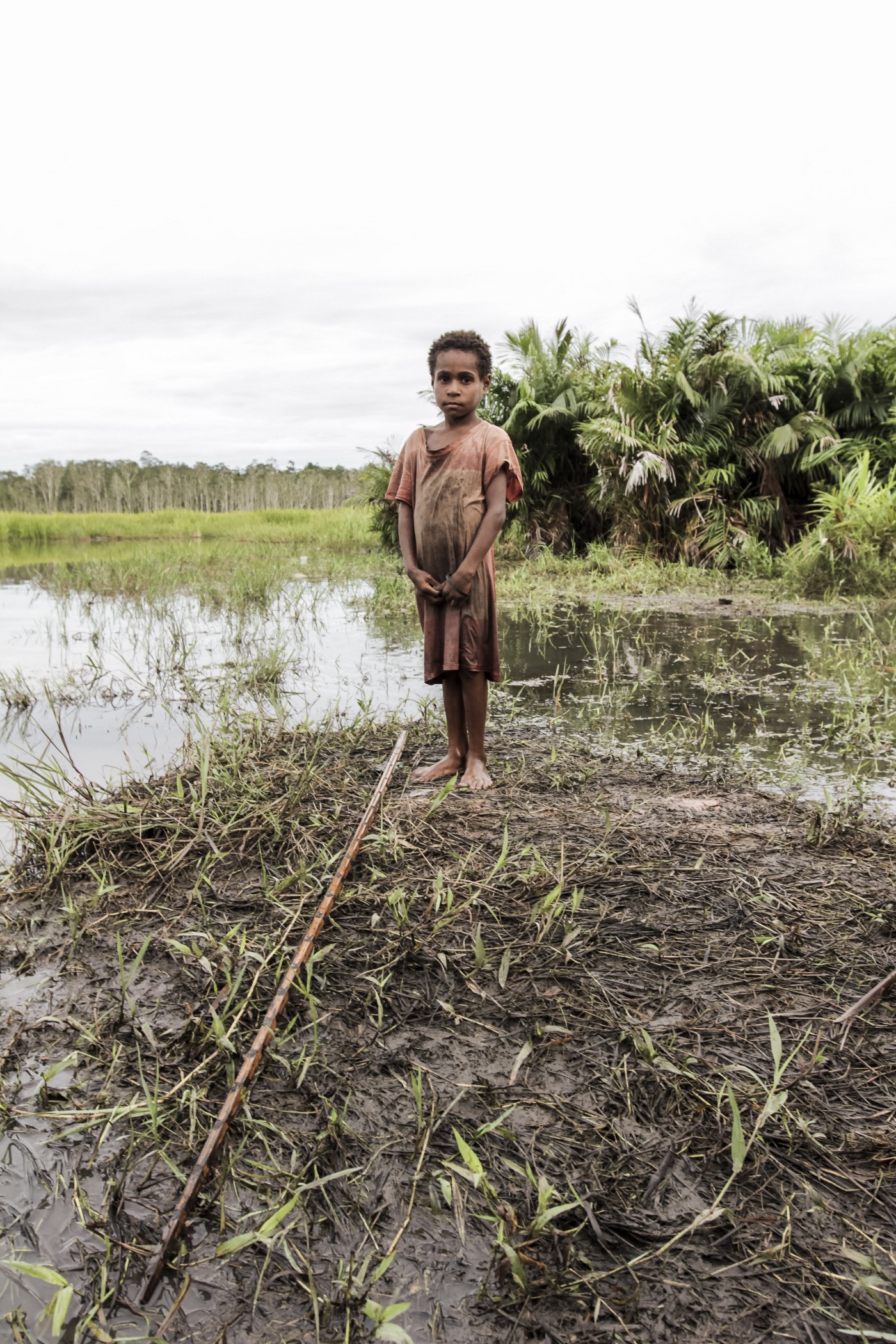
Child in Merauke, 2012.
What realistic changes could occur that might improve the
situation for Marind and other indigenous Papuans?
At the grassroots level, I think community capacity-building
is key. This would involve increasing communities’ access to national and
international remedy mechanisms, and their knowledge of their rights under
national and international law, particularly to their lands and livelihoods.
But these grassroots initiatives would also need to be accompanied by legal
reform that would harmonize national laws with the requirements of international
law. There’s a gap between these two systems at the moment. Sustainability
standards like the RSPO [Roundtable on Sustainable Palm Oil] are making
important steps to push for a rights-based approach to oil palm production. But
again, these standards can only be truly effective if there is legal reform.
Otherwise, even companies that are trying to implement a comprehensive FPIC
[Free, Prior and Informed Consent] process may find themselves stuck between
the requirements of the RSPO and the requirements of national laws. Of course,
legal reform takes time — it won’t resolve the problems faced by Marind today.
But on the long term, it may make a difference to future generations of Marind
and increase their capacity to defend their rights to lands and livelihoods
more effectively.
All photos for this article were provided by Indonesian film-maker Nanang Sujana. You can watch Nanang’s 2012 film on land grabbing and indigenous rights in Merauke, Mama Malind su Hilang (Our Land is Gone), here:
As of May 2019, The Gecko Project has become an independent organisation in its own right. However, Earthsight is continuing to investigate these issues in Indonesia, and their overseas connections.
